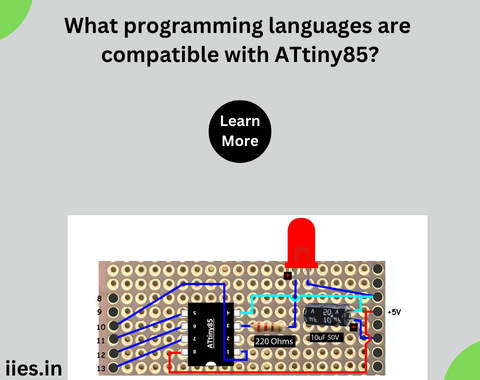
In the realm of microcontrollers, the ATtiny85 stands out as a tiny yet powerful chip that finds its applications in various embedded systems and projects. Understanding the programming languages compatible with ATtiny85 is crucial for developers and hobbyists looking to harness its potential. This article delves into the diverse programming landscape of ATtiny85, exploring the languages that enable enthusiasts to unlock the full capabilities of this miniature marvel.
The C programming language is the cornerstone of ATtiny85 development. Known for its efficiency and versatility, C provides a low-level approach to programming, allowing developers to have fine-grained control over the hardware.
The AVR-GCC (GNU Compiler Collection for AVR) is the go-to compiler for C programming with ATtiny85, facilitating the conversion of C code into machine-readable instructions.
Arduino IDE: Simplifying ATtiny85 Development
Arduino, with its user-friendly Integrated Development Environment (IDE), has become synonymous with microcontroller programming for beginners and experts alike. With the help of the TinyCore library, the Arduino IDE extends its support to ATtiny85. This library acts as a bridge, enabling Arduino code to be compiled and uploaded onto the ATtiny85 microcontroller. This approach allows developers to leverage the simplicity of Arduino programming while harnessing the capabilities of the ATtiny85.
Assembly Language: Unleashing Maximum Performance
For those seeking the utmost control over the ATtiny85’s resources, assembly language provides a direct interface with the microcontroller’s instruction set. While it may seem daunting to some due to its low-level nature, assembly language allows programmers to optimize code for performance-critical applications. AVR Assembly is the specific dialect used for ATtiny85 programming, and it provides access to every feature and register of the microcontroller.
Python: A High-Level Contender for ATtiny85 Development
Although not as prevalent as C or assembly language, Python has made its mark in the world of microcontroller programming. The Micropython project has extended its support to ATtiny85, enabling developers to write Python code that runs directly on the microcontroller. While Python might not be the first choice for resource-intensive tasks, its simplicity and readability make it an attractive option for certain applications.
Bascom-AVR: A Basic Alternative
Bascom-AVR, a high-level programming language, provides an easy-to-learn alternative for ATtiny85 development. Offering a syntax similar to BASIC, Bascom-AVR simplifies the coding process for beginners. It comes with a user-friendly IDE and a rich set of libraries, making it an accessible choice for those who want to focus on application logic rather than delving into the intricacies of low-level programming.
Flowcode: Visual Programming for ATtiny85
For those who prefer a visual programming approach, Flowcode offers a graphical programming environment for ATtiny85. With a drag-and-drop interface, Flowcode allows users to design their applications by connecting graphical blocks that represent different functions. This visual programming language abstracts the underlying code, making it an excellent choice for quick prototyping and educational purposes.
MakeCode: ATtiny85 Meets Blocks Programming
MakeCode, developed by Microsoft, is a block-based programming language that supports ATtiny85 through various hardware platforms. Aimed at beginners and educators, MakeCode uses a visual interface where users drag and drop code blocks to create programs. This approach simplifies the learning curve and allows enthusiasts to experiment with ATtiny85 without delving into traditional text-based coding.
Expanding the Horizons of ATtiny85 Programming: Advanced Techniques and Emerging Trends
As the popularity of ATtiny85 continues to grow, developers are exploring advanced techniques and emerging trends to push the boundaries of what this tiny microcontroller can achieve. Let’s delve deeper into some of these aspects:
Optimizing Code Size and Performance:
The limited program memory (flash) and RAM of ATtiny85 necessitate efficient code optimization. Advanced C programming techniques, such as inline assembly and compiler optimizations, play a crucial role in minimizing code size and maximizing performance. Developers often use the PROGMEM attribute to store constant data in flash memory, reducing the usage of precious RAM.
Interrupt-Driven Programming:
ATtiny85 supports interrupts, allowing developers to respond to external events in a timely manner. Interrupt-driven programming is particularly useful for real-time applications. By carefully managing interrupts, developers can optimize code execution, ensuring responsiveness without compromising the overall system stability.
Custom Bootloaders and Firmware Updates:
Creating custom bootloaders for ATtiny85 enables developers to implement firmware updates without requiring a dedicated programming tool. This facilitates remote updates, a crucial aspect in applications where the microcontroller is embedded in inaccessible locations. Custom bootloaders can be tailored to specific project requirements, providing flexibility and scalability.
Integration with IoT Platforms:
As the Internet of Things (IoT) continues to gain momentum, developers are exploring ways to integrate ATtiny85 into IoT ecosystems. Libraries and frameworks designed for lightweight IoT communication, such as MQTT (Message Queuing Telemetry Transport), allow ATtiny85 to communicate with cloud platforms, enabling remote monitoring and control.
Low-Power Techniques:
ATtiny85 is renowned for its low power consumption, making it ideal for battery-powered and energy-efficient applications. Developers employ various low-power techniques, such as sleep modes and power-down modes, to minimize energy consumption during idle periods. Achieving optimal power efficiency is crucial for extending the battery life in portable and remote sensing applications.
Simulations and Virtual Prototyping:
With the advancement of simulation tools, developers can simulate the behavior of ATtiny85 programs before deploying them on the actual hardware.
The ATtiny85, despite its compact size, offers a versatile platform for a wide range of applications. The availability of diverse programming languages ensures that developers, regardless of their skill level or preference, can engage with the ATtiny85 to bring their ideas to life. Whether it’s the robustness of C, the simplicity of Arduino, the power of assembly language, or the accessibility of visual programming, the ATtiny85 provides a canvas for creativity in the world of embedded systems. As technology continues to advance, the programming landscape of ATtiny85 is likely to evolve, offering even more options for enthusiasts eager to explore the capabilities of this diminutive yet potent microcontroller.
Indian Institute of Embedded Systems – IIES